Rainham Shops in November 1977
This promotion for shopping in Rainham was published in Action Forum magazine and shows some of the shops that were trading in the area in 1977.
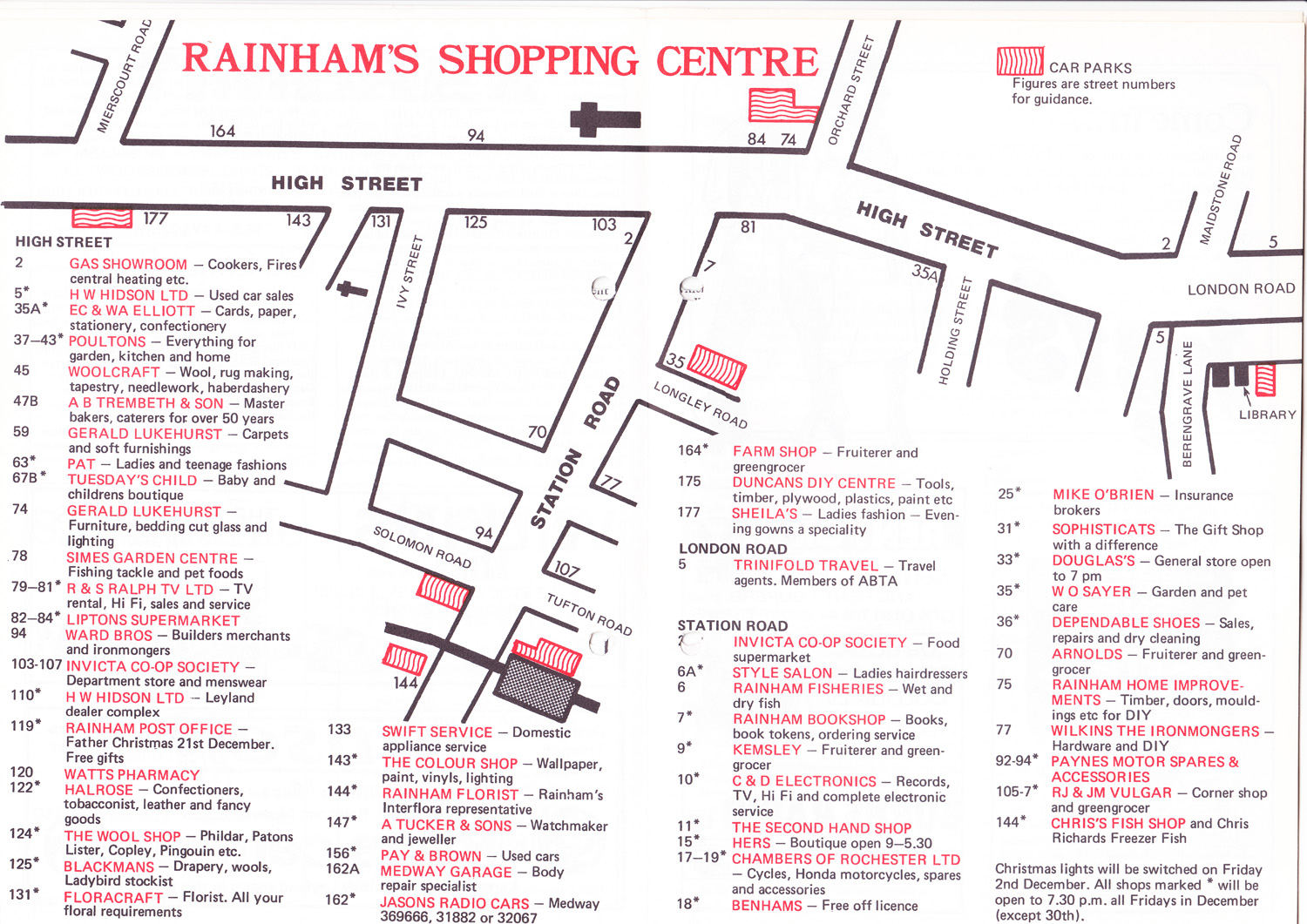
This promotion for shopping in Rainham was published in Action Forum magazine and shows some of the shops that were trading in the area in 1977.

Planning permission has now been granted for the Rainham District Shopping Centre to be built on Council-owned land north of the High Street and west of Station Road. The developers are to be G.E. Wallis & Sons, and the architects for the scheme are Richard Sheppard, Robson and Partners. The intention is to provide a quiet pedestrian shopping area, the design of which will complement the small-scale and informal character of the existing village centre. The shops will be reached on foot from both the High Street and Station Road, as well as from a new car park to be provided at the rear. Vehicles will gain access to the Centre by a new road linking Holding Street and Longley Road. In all, the scheme provides for 31 shops and some offices at first-floor level. New public conveniences are also included in the scheme. The scheme represents the culmination of many years spent in planning and negotiating and should help to revitalise the village core and re-establish it as a centre of social and economic activity. It is hoped to start building in the late autumn and it is currently anticipated that the first shops will open in a little over a year after the commencement of works. The centre as a whole should be open within two years of commencement. Plans of the centre have been on display in Rainham Library for some months and can still be seen there or at the Department of Architecture and Planning at the Municipal Buildings.
Rainham is to have a new look! This may seem a familiar cry to many of the native residents but we are pleased to be able to publish an artistic plan in our centre pages. The plan shows how the site between Station Road, Longley Road and the High Street will look (optimistically) in two years time, and anyway quite soon. It will be a sad moment when the old Church School, now the home of Rainham and Wigmore Community Association, is finally demolished. I am sure it will be a time of nostalgia to all but the very newest inhabitants of Rainham. However a new shopping centre must give more life to a village that really hadn’t quite grown to a town despite its 40,000 residents.
In the Action Forum from November 1978 it states that the Longley Road car park is virtually completed and will be ready in time for Christmas and be available as a free car park for Christmas shoppers. It also mentions that the shopping centre is "shooting up" and that Savacentre has opened in Hempstead Valley.
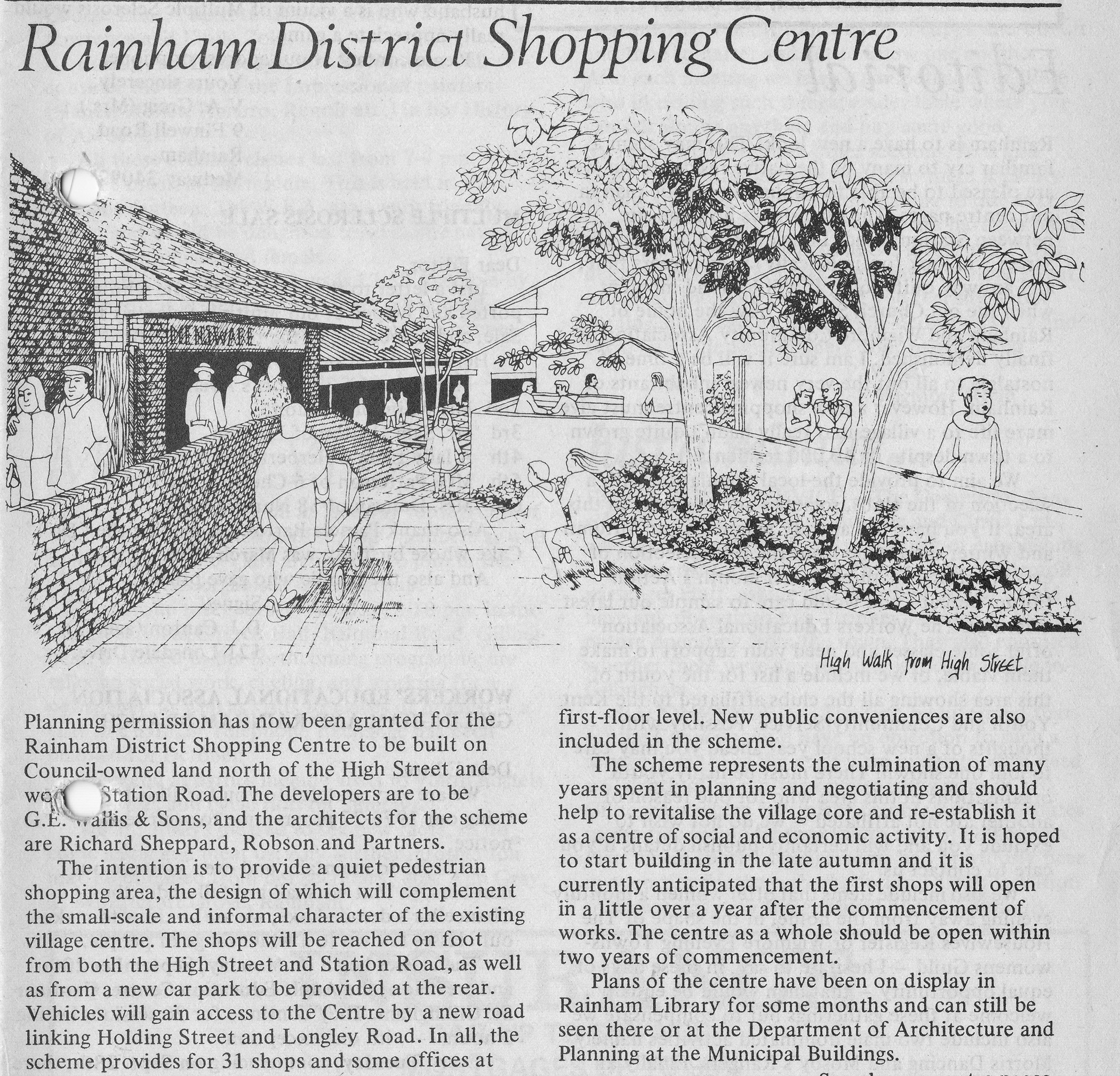
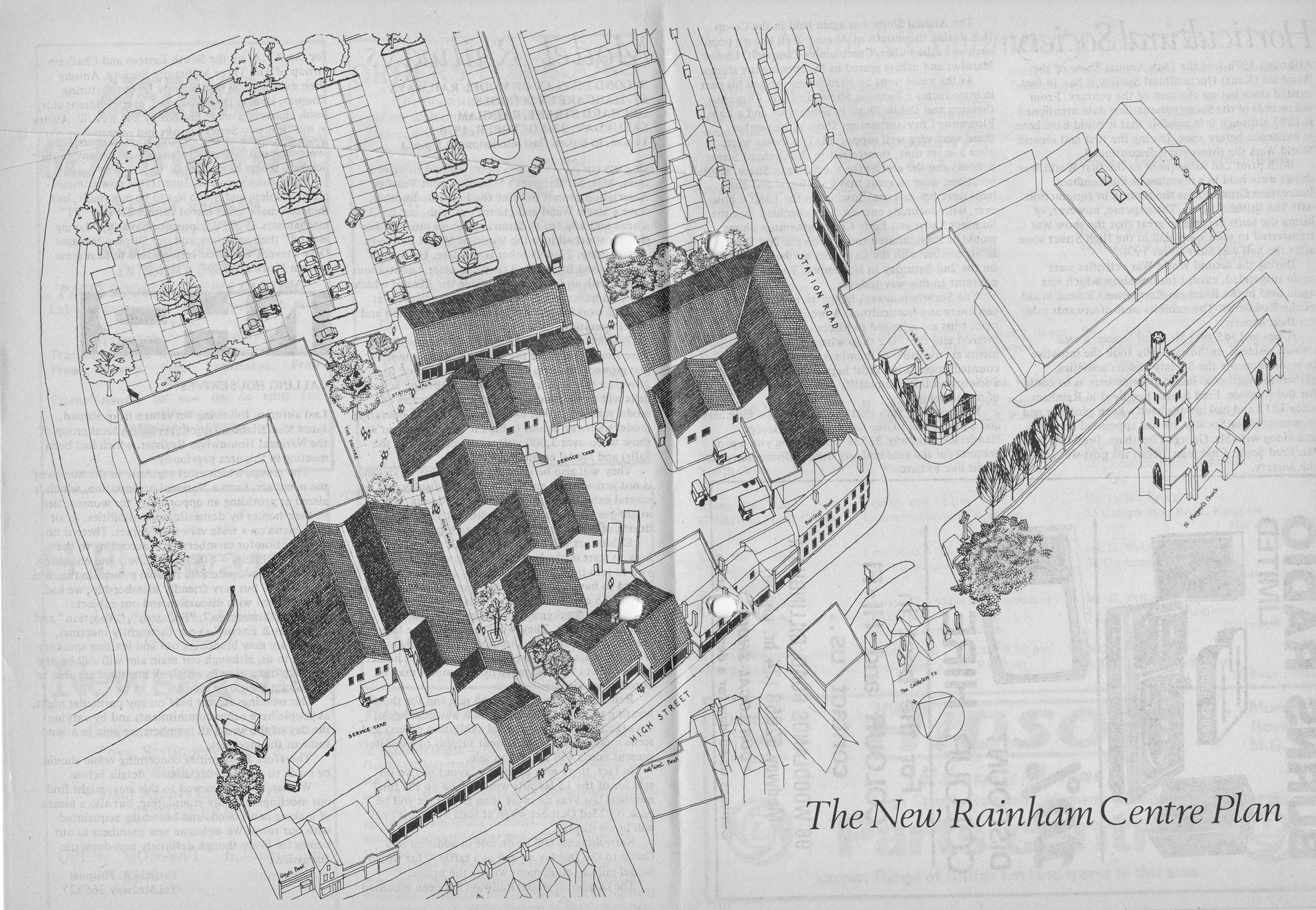
I had expected to be writing, this month, about the end of Gillingham Borough Council but the last meeting of that authority is arranged for 24th March (a week from the time of writing) so, all being well I hope to comment on this historic event next month. It’s obviously a period of great change as the management of The Rainham & District Co-operative Society Ltd have announced that they are to close all activities here in Rainham on 4th April. This is a terrible blow to the prosperity of the Shopping Centre which will now rely, almost entirely, upon Tesco continuing to trade, remember that they stated that trading would be continued for at least five years after the new store opened at Rainham Mark on 1st February 1994.
One would hope that the closure of the Co-op will encourage Tesco to remain open in the Shopping Centre as so many older folk would find it difficult to shop elsewhere. The level of rents in the centre are of great concern to many of the traders as the last review took place when rents were far higher than now and rents charged under the leases never go down. It’s ironic that we’re dependent upon one supplier for grocery etc in Rainham when, pre war, we had the Co-op, International, Perks, Roses and Quinells and many smaller well stocked shops. I have information on the origin of the Co-op in Rainham somewhere but my ‘big box’ filing system has failed me this time so I am grateful to Mr Aubry who has collated a lot of information on Kent Co-ops and the Labour Party.
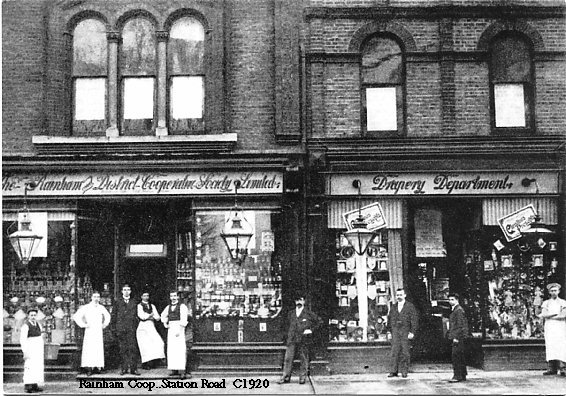
On 25th November 1872 a meeting was held to consider opening Co-operative store facilities here in Rainham but nothing developed until 1891 when Sittingbourne Co-op opened a branch shop. At that date Rainham, as part of Milton Regis RDC, was far closer to Sittingbourne than Gillingham. It was just 102 years ago, in 1896, that Rainham and District Co- operative Society Ltd was born. I’m pretty sure they started at 1/2 Station Road which are the top shops on the eastern side immediately below the garden of the Whitehorse PH, that’s where they remained until the Shopping Centre was opened. I do have an advertisement from Kelley’s Directory of 1908 which quotes the annual sales at nearly £16,000 with a profit of £1,500, a membership of 505 when the population of Rainham was around 4,000. The Share Capital was £5,447 with an entrance fee of l/- (5 p). The first telephone was number 4.
The sales covered Grocery, Hardware, Crockery, Tinware, Drapery, Boots, Clothing, Furniture, Bakery, Pastry, Corn, Coal and Meat. Many people worked long hours, often six days a week in the early part of the century so could seldom get to the shops, members would leave notes for the baker ordering replacement boots or items of clothing etc. Many didn’t lock their back door or if they did then those making regular deliveries would know where the key was placed so that they could leave deliveries of bread etc on the kitchen table. The . x Women’s Guild, much involved in the education of women was started in 1900. The early Managing/ Secretary was Mr A.W. Barnes and subsequent managers Mr Harry Budd and Mr Reg Lucas are still remembered. The new large shops and hall, opposite the Church were opened in 1928 costing £10,000, designed by Mr F. Mattocks and I think built by Bridges. It’s ironic that this was opened in the same year that the Extension to the Boundary Act was passed which transferred Rainham to Gillingham and the building has been demolished in the same year that Gillingham is to be absorbed within the new Medway Towns authority.
Many of us remember with affection the dances in the old Co-op hall and the large clock which hung from the frontage until it was considered dangerous during the war and taken down. Many Co-operative Societies were closely affiliated to the Labour Party and Rainham was no exception as most of the Committee were also ardent Labour supporters. I recall the Conservatives putting up candidates in the 1950s in an endeavour to obtain control of the Gillingham Co-operative Society. It was probably because of the political affiliation that the Co-ops played an important role in community activities and the dividend earned on purchases enabled many members to obtain shoes and clothing etc. This dividend was, I think, paid quarterly when members would queue up the stairs to the office in alphabetical groups at advertised times and you will still find those who were very young children in pre war years who can immediately recall their mother’s membership number. At one time tin type coins were issued.
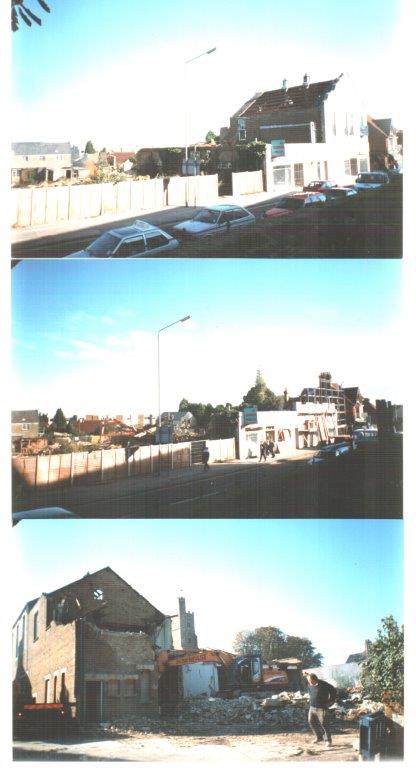
One rather unique feature which each shop used was the overhead cash transmission system (I forget its patent name) whereby the cash and bill were sent in a two piece wooden cup by spring action from the point of sale to the office and in due course of time returned with change and receipt, absolutely fascinating to young children! The Co-op fetes were an outstanding event in pre war years, members’ children were seated in long rows at the Recreation Ground and then supplied with eats and tea, each one taking his or her own mug. There were great urns of tea poured out by helpers in white enamel jugs with sandwiches, buns, various types of slab cake and sometimes fruit and sweets. Much of the excitement came from the free rides, swings, roundabout and various side shows. I believe that non members’ children had to pay for the tea and the sideshows! The Rainham Co-op Treats
The carnival was another pre war feature when decorated horse drawn carts and vehicles paraded through some of our main streets with many youngsters in attendance. Rainham pre war was a hotbed for football and the Co-op had a very successful team in the Wednesday league and won many trophies. I was speaking to Harry Howting recently and he rattled off the team of his era as though they played last Wednesday. Edgar Apps, Joe Cox, Percy Payne, Bill Costen, Sid Norris, Dave Coppins, Sid Muggleton, Harry Howting, Percy Major, Len Stockey, Sid Skinner and later Stan Lacey. I’m sure that older residents will have many memories as Rainham Co-operative Society Ltd had a major influence on our community pre war with many personalities such as the departmental managers like Bill Samson, Mrs Ovenden, Mr Lacey, Mr Norrington (later Maidstone Road) then there were the office staff like Mr Mattocks and Mr Waterman and Committee (like Messrs Bowra, Day, Dartnell and Ransley. I hope that some previous employees or their children will write to ‘Action Forum’ so that far more of the history of the Co-op and those who made it tick may be preserved for posterity.
Freddie Cooper
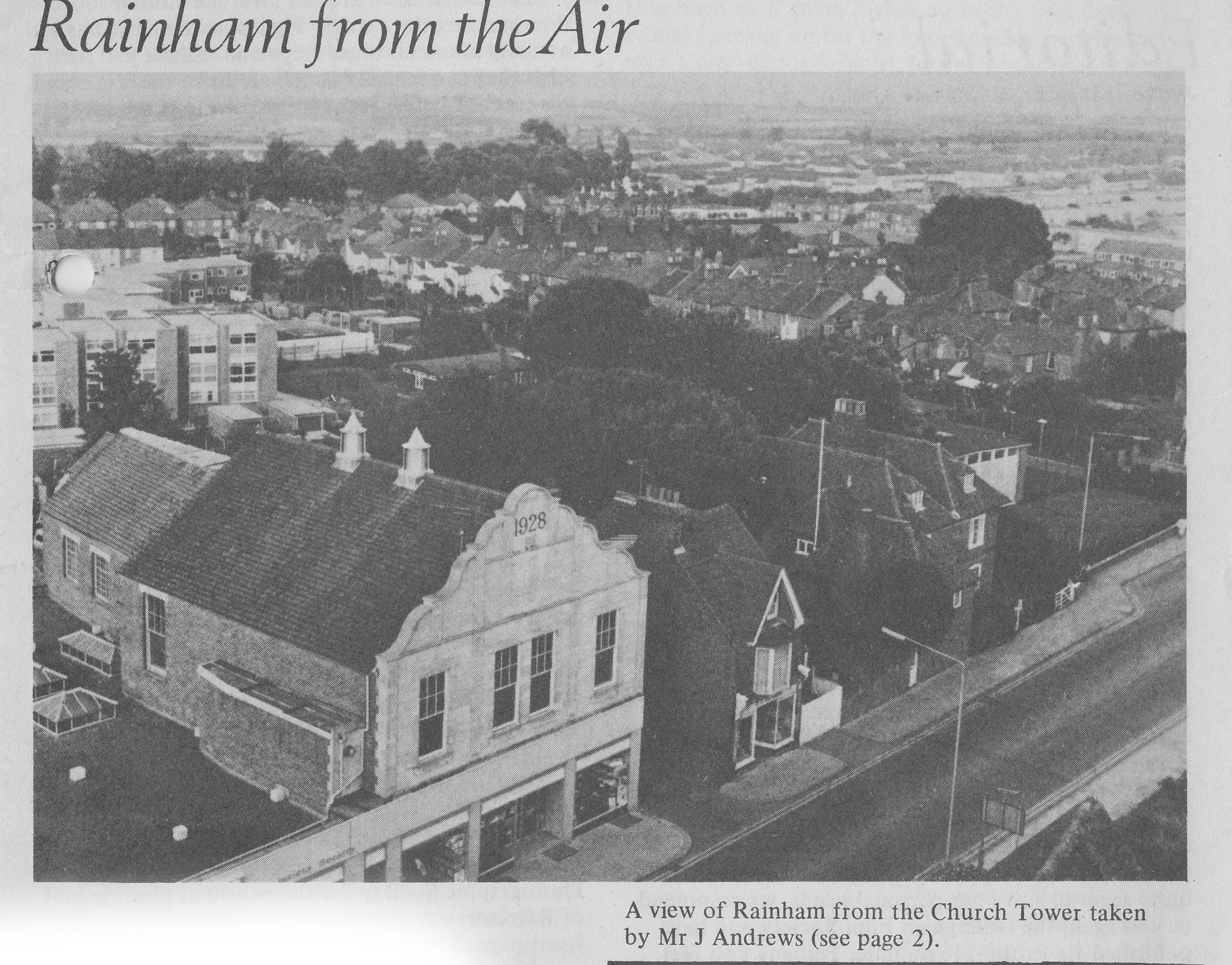
This article about prefab (pre-fabricated houses from after the Second World War WW2) is based on information originally published in Action Forum in 2021 and started with the August 2021 cover photo taken on the site of what is now Clematis Avenue (off Fairview Avenue) Wigmore.
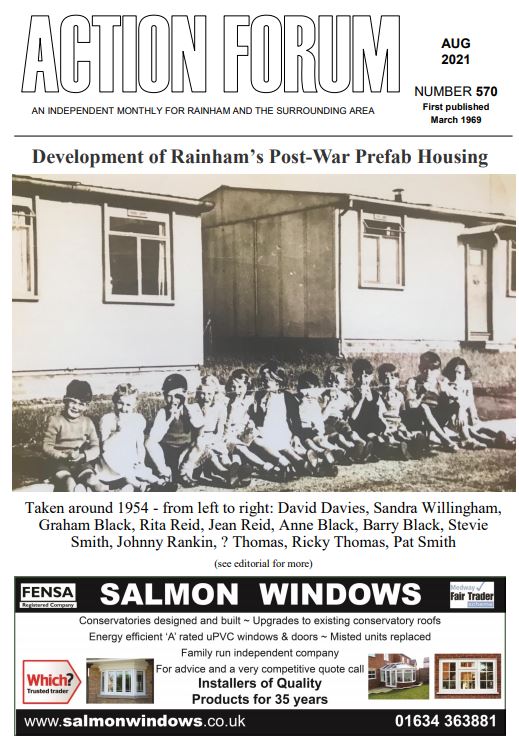
It was shared by my cousin Mrs Anne Pearce, now retired in Bexhill, and with her by her life-long friend Mrs Pat Kay. It shows the youngsters from that tight knit community and was taken by Pat ’ s late father, Mr Steve Smith. They think the photograph was taken in 1953 (the prefabricated houses having been built post war in 1947 and lasted to 1967/68 when residents were rehomed to alternative council houses in Rainham and Gillingham). They were common sights across the UK, where housing shortages were met with these asbestos and corrugated iron constructions. Loaded onto lorries the prefabs were delivered where they were needed and erected on 30ft by 22ft prebuilt brick foundations in a matter of hours. They are remembered fondly, with all ’mod cons' provided but freezing cold in winter. There were long gardens to these plots, with a shed provided, and my Uncle Bert kept chickens and grew many fruits and vegetables. There were other similar prefab communities across Rainham and Gillingham, perhaps recalled by our readers? Locations mentioned to us have been: Russells Avenue (end of Scott Avenue) and the top of Salisbury Avenue in Rainham. They were also in Scott Avenue leading from Solomon Road up to the A2 opposite Meredale School, Solomon Road and Sunderland Square, Maidstone Road (below what is now Bettescombe Road), Derwent Way, Taverners Road, Wakeley Road and some opposite the Railway Hotel by the Station. It turns out there is a prefab museum website (www.prefabmuseum.uk) which details the prefab design and origins and includes many photos and memories shared. The photo elicits for me memories of my Aunt Dolly cooking in the small kitchen, the chiming clock on her mantelpiece, the shiny brass tools around the fireplace. Strange how a single photograph can trigger so many nearly sixty year old connections. The retention of old family photographs, kept in shoe boxes or albums, some with names and dates carefully written on the back, assist our recall, whilst others lose their significance by the year as relatives pass who could put a name to a face, place or date to when they were taken. I rescued our family photo archive from Australia when my mother passed, which she had assembled over many years. Such archives are precious family treasure and dug out occasionally to refresh memories of older times.
You can see the prefabs in the distance in this photo of Rainham from 1958 which would become Sunderland Square/Scott Avenue/Russells Avenue
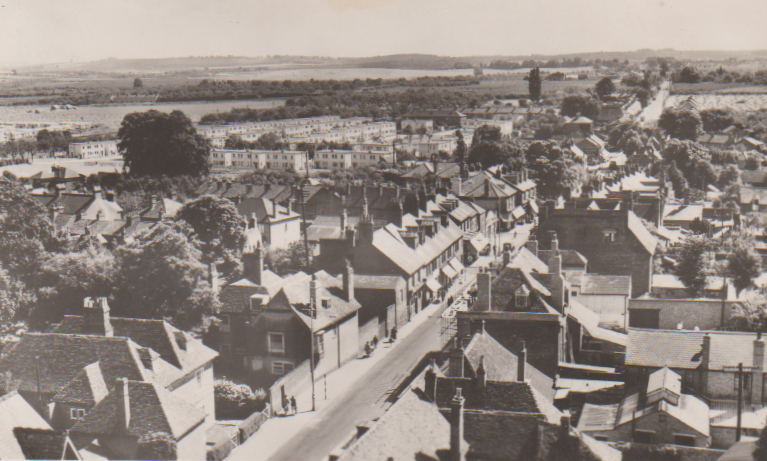
Your cover picture on the front of the August magazine certainly brought back childhood memories of living in a Rainham prefab, when we had not a care in the world, and the sun always shone! There were some errors in the locations mentioned. We lived in Russells Avenue, which was at the top of Solomon Road, where it still is today, not the end of Scott Avenue. There were eleven “houses” there, all of which were demolished and replaced with permanent housing in the early sixties I believe. The houses mentioned in Solomon Road, Scott Avenue and Sunderland Square were not actually prefabs; they were constructed from what was basically a steel frame with reinforced concrete panels. These houses were not intended to be temporary, as in the case of prefabs, but I believe there was an unforeseen problem with the degradation of the concrete, resulting in their premature demolition in 1997. The 38 houses in Sunderland Square were replaced by a development of over 100 houses. The main omission on your list is Mardale Road, which, along with its neighbour Wakeley Road, formed probably the biggest concentration of prefabs in Rainham. My family left Russells Avenue in 1958 to move to Gillingham, as the prefabs had already exceeded their intended lifespan, and, let’s just say they were “past their best!” I enclose a photograph of “our gang” taken in Russells Avenue in 1957. From left to right: Mick Curness (no.9); Keith Relph (no.8); my brother Keith Austin; Brian Austin (me) (no.6); and Robert Goodwin (no.4). My brother lives in Wigmore, and I in Rainham. I haven’t seen the other three for a very long time, but I believe Mick Curness went to Canada and Keith Relph to Northern Ireland. Although prefab winters had become decidedly uncomfortable by the late fifties, most of the prefab occupants I have spoken to over the years seem to remember their time in them with affection. I certainly do. P.S. In the background of the photograph my father, Jack, can be seen polishing his beloved motor bike and sidecar combination. He never seemed to be as fond of any of his subsequent cars as he was of his “bike.”
Action Forum is a free monthly magazine that is distributed to the Rainham area covering Wigmore, Parkwood and Hempstead as well. This archive covers old copies of the magazine dating back to its initial publication in 1969 and give a fascinating glimpse into life in Rainham over the last 50 years.
Link to Article Index - Action Forum Index - Photos and Articles from 1969 onwards
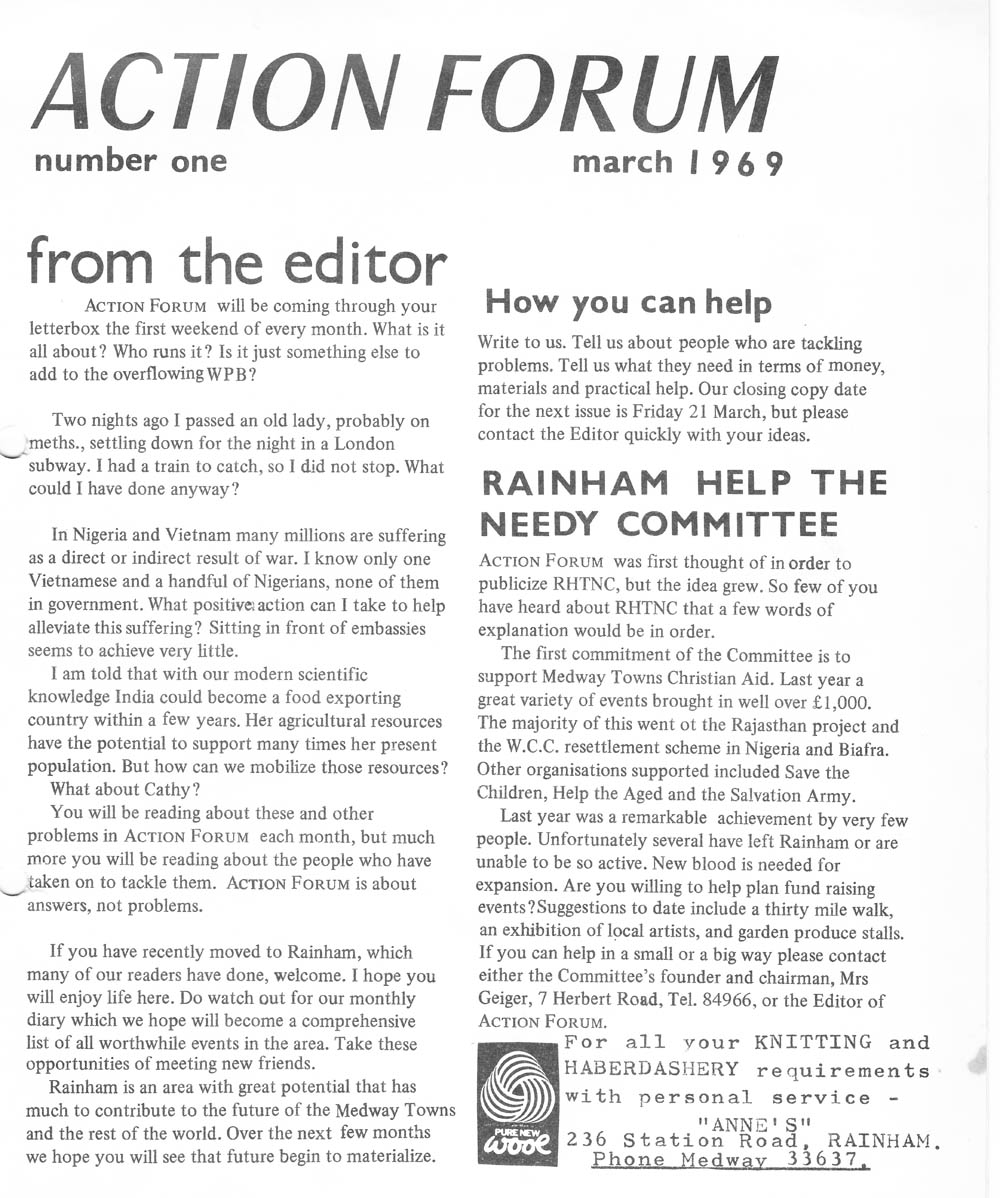

Historical tales
Local Events
Photos
Rainham Life